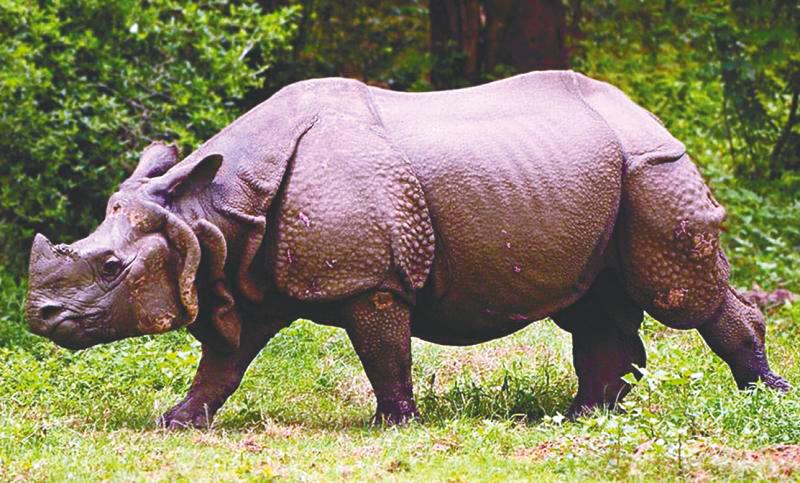STEP into a world where the earth’s pulse echoes through the untamed wilderness, where towering giants, with their iconic horns, stand sentinel in an epic saga of survival against formidable odds.
This is the mesmerising world of rhinoceroses – magnificent creatures that appear as if conjured from a primeval reverie, roaming untamed and free.
Embark with us on an unparalleled expedition as we reveal the extraordinary secrets of these majestic beings and the awe-inspiring efforts to safeguard their enduring legacy in the wild.
Physical might of rhinos
Rhinoceroses are the colossal giants in the animal kingdom, distinguished by their imposing stature and remarkable physical characteristics. These creatures possess sturdy frames covered in a resilient, armour-like hide.
Their most distinctive feature, the horn, is composed of keratin, the same substance found in human hair and nails. Despite misconceptions, the horn is not ivory. However, it is frequently targetted by poachers due to its perceived medicinal and ornamental value, placing these animals perilously close to extinction.
There are three distinct rhino species, each boasting its own unique characteristics and narratives.
Let us begin with the White Rhinoceros (Ceratotherium simum). Despite its name, which can be misleading, it has no connection to its colouration, rather, it originates from the African word “wijde”, accurately depicting its broad mouth.
This mighty creature has two subspecies: the southern white rhino, a conservation success story, and the northern white rhino, teetering on the edge of extinction.
Next is the Black Rhinoceros (Diceros bicornis), notable for its solitary and occasionally cantankerous disposition. Sporting two distinctive horns, these enigmatic creatures roam various regions across Africa. Poaching has decimated their numbers, leading to a concerning decline.
Lastly, our expedition transports us to Southeast Asia and the Indian subcontinent, where we have the Javan, Indian and Sumatran Rhinoceroses. These elusive species, native to Indonesia and the Indian subcontinent, are among the rarest of the rhino clan and are on the precipice of extinction.
The Javan Rhinoceros (Rhinoceros sondaicus), a true wilderness gem, and the shaggy Sumatran Rhinoceros (Dicerorhinus sumatrensis) are in a state of critical endangerment, making their conservation a pressing race against time.
Meanwhile, the Indian Rhinoceros (Rhinoceros unicornis), a formidable member of the rhino trio, is also facing the challenges of a rapidly changing world, underscoring the urgency of our conservation efforts.
Present population
At the dawn of the 20th century, the continents of Africa and Asia were home to around 500,000 rhinos. However, the persistent poaching and habitat loss over several decades took its toll, causing the rhino numbers to plummet to 70,000 by 1970.
Today, a mere 27,000 rhinos remain in the wild, with only a scant few surviving beyond the confines of national parks and reserves.
The Javan rhino population is now limited to a solitary national park on the northern tip of Indonesia’s Java Island, while a subspecies of the Javan rhino was officially declared extinct in Vietnam in 2011.
On an optimistic note, the population of the great one-horned (or Indian) rhinos has increased from around 200 at the turn of the century to around 3,700 today due to successful conservation efforts.
Although the progress with the great one-horned rhino is one of Asia’s biggest success stories and has moved from endangered to vulnerable status, these rhinos still face persistent threats from poaching for their horns and the loss of their natural habitat.
In Africa, protected sanctuaries have achieved remarkable success in reviving the southern white rhino population, a species that was once believed to be extinct.
Despite this success, the Western Black and Northern White rhinos have recently gone extinct in the wild. The only remaining Northern White rhinos are kept under 24-hour surveillance at Ol Pejeta Conservancy in Kenya.
Black rhinos, on the other hand, have seen a doubling in their numbers over the last two decades, rising from fewer than 2,500. Nevertheless, the current population of Black rhinos is only a small fraction of what it once was in the early 20th century, estimated to be around 100,000.
Human activities and environmental factors have primarily driven the decline in the overall rhino population. Foremost among these is rampant poaching for their horns, which are highly valued in illegal markets.
The unrelenting demand for rhino horns has fuelled a sharp increase in illicit hunting, resulting in the killing of these majestic creatures.
Additionally, habitat loss and fragmentation due to agriculture, urbanisation and infrastructure development have encroached upon rhino habitats, leaving them with limited space to roam and find food.
Climate change and associated factors, such as prolonged droughts and altered vegetation patterns, have also impacted their habitat and access to water sources.
Combating these multifaceted challenges is paramount to ensuring the survival of rhino populations worldwide.
The plight of rhinos serves as a poignant reminder of the urgent need for collective action in conservation.
Their decline is a stark warning of the consequences of human disregard for our natural world.
However, as renowned conservationist Jane Goodall aptly said: “What you do makes a difference, and you have to decide what kind of difference you want to make.”
We all have a role to play in the preservation of these iconic animals. By supporting reputable conservation organisations, raising awareness, reporting wildlife crime, advocating for stronger protection measures, reducing our carbon footprint and educating others, we can contribute to the survival of rhino populations.
In doing so, we ensure the future of these majestic beings and protect the intricate ecosystems they inhabit, leaving a lasting legacy of compassion and stewardship for generations to come.
The writer is the founder and CEO of BioDB.com, a group tasked with collecting conservation data, raising awareness for biodiversity loss and fundraising. Comments: letters@thesundaily.com











